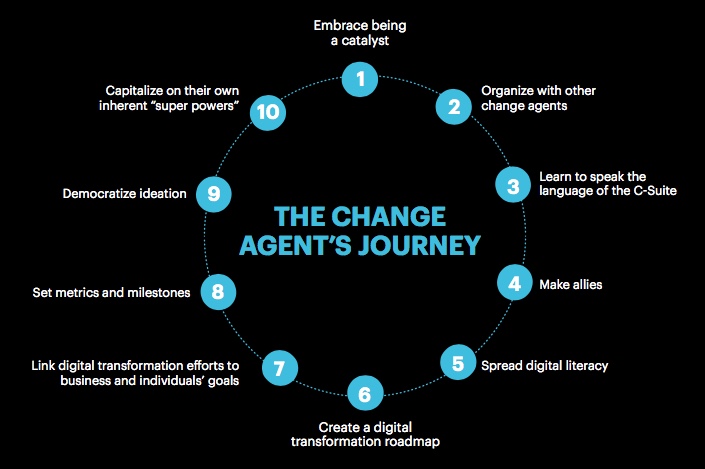As technologists, we tend to get caught up in the computer side of things when it comes to try to get stuff done in our organizations. So often we forget that the real drivers of change are the people behind the screens. In new research that my colleague Brian Solis has just published, he documents exactly how enterprise digital transformation happens, and talks directly to some of those “change agents” that he has known for decades as an analyst covering the IT scene. His Manifesto is available now for downloading and reading, I strongly suggest doing so. (Other than registering your email, it is free of charge.)
 With most organizations, “these digital transformation efforts often take place in isolated pockets, sometimes with little coordination and collaboration across the enterprise,” he writes. Often it is a solitary individual who drives change and introduction of particular digital technologies and methods at a grassroots level — and often fails to go further across the enterprise. His manifesto puts together a solid ten-point plan (shown here) if you want to be more effective in bringing this about at your company. This includes embracing yourself as a catalyst, obtaining leadership support, creating a roadmap and democratizing idea creation. Some of these are obvious, some aren’t.
With most organizations, “these digital transformation efforts often take place in isolated pockets, sometimes with little coordination and collaboration across the enterprise,” he writes. Often it is a solitary individual who drives change and introduction of particular digital technologies and methods at a grassroots level — and often fails to go further across the enterprise. His manifesto puts together a solid ten-point plan (shown here) if you want to be more effective in bringing this about at your company. This includes embracing yourself as a catalyst, obtaining leadership support, creating a roadmap and democratizing idea creation. Some of these are obvious, some aren’t.
He says that “digital transformation is more of a people problem than a business problem. Trust is the least measurable but most important factor to build.” Without this trust, your colleagues can sabotage or block your efforts. One of the biggest obstacles in building trust is in managing your own ego as a change agent. When you display too much ego, you make the change all about you, rather than the benefit to your company. The same is true when managing your colleagues’ egos too.
On the other side of this is managing your own doubts about what you are trying to do. “Although it may seem counterintuitive to manage detractors, change agents ought to listen closely to their feedback. It is better to let them voice their concerns than to let them detract in secret.” Indeed, listening is often overlooked when advocating change. The better listener you are, the more you’ll get done.
Solis mentions that when a change agent has the full buy-in of the executive suite, real change becomes possible and turns from a suggestion to a corporate mandate.
“Digital Darwinism is increasingly becoming either a threat or an opportunity based on how organizations react to change,” he says in his report. Digital change agents can become the next generation of leaders and help to be instrumental in having their companies more effectively compete in this digital economy.
I’m sure that this is a good tool for planning and making institutional change. I’m not sure that it is the only way or always the best way.
I was well into my career before I realized that I was a change agent/risk taker. I saw myself as someone who saw something that needed to be done and doing what I could to make it happen. Thinking back on the changes that I was a part of, I realize that I actually did many of the steps without conscious thought. Just seemed to be the way to get things done.
I have not had and will not have the opportunity to read the complete document. So I don’t know if there is a portion that talks about the persistence often needed to make a change. There is a need to recognize why a failure happened and what to change for the next try.
Being a change agent in my career has been a great ride and would recommend it to anyone who has the creative, social, networking skills that it takes to succeed from time to time.